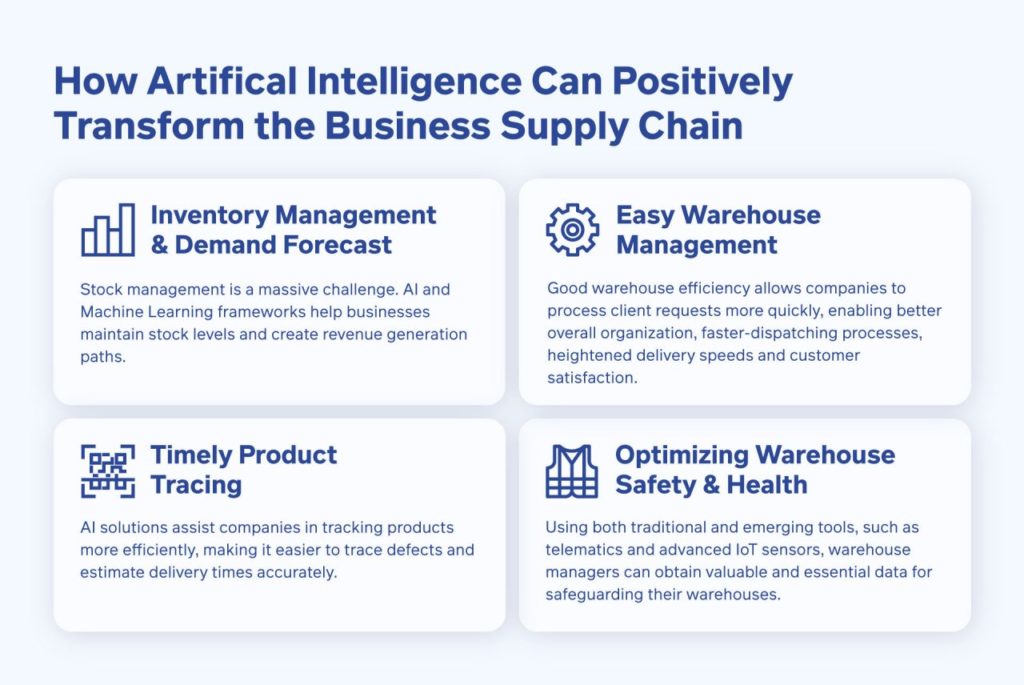It has been a while now that smart and emerging technologies such as artificial intelligence (AI) and the Internet of Things (IoT) have introduced disruption in every field; the entire supply chain network remains no exception in this regard. From raw materials sourcing to factory floor productivity, these technologies have proved to be a game-changer in every segment.
Moreover, the global pandemic has further pushed the need for heightened agility and flexibility. These smart and emerging technologies have brought in a paradigm shift in terms of business value while introducing opportunities directed towards better utilization of human resources and capital.
Considering that data is the new fuel, companies are able to gain better insights through the deployment of these emerging technologies. Through analysis of data-driven intelligent platforms, it is now possible for supply chains to make precise predictions and informed decisions.
In fact, AI holds the potential to assist with all aspects of the supply chain. From the ability to create self-adjusting supply chain plans to enabling manufacturing operations to self-optimizing processes, AI is capable of making a world of difference. According to a survey by Supplychaindive, 90 percent of the respondents believe that AI will transform the supply chain for the better by 2025.
What type of role should AI play in logistics? Get insights here!
Adding AI to the Supply Chain: Advantages and Challenges
It is anticipated that building a more intuitive supply chain network that benefits from AI – both economically and in a way that is societally inclusive – is likely to be a challenge. In addition, with the introduction of these emerging technologies, job profiles are changing dramatically.
Considering that many organizations are looking forward to AI as an integral aspect in the future, businesses would be required to take into account how such smart technology will change their human resources needs and the skills needed by their supply chain workforce.
Since there would be scope for better predictions and recommendations, the need for employees who are capable of making smart decisions based on that information would rise considerably. Moreover, technical reskilling would be the need of the hour to keep pace with the disruption.
A few companies have already jumped the bandwagon and are already taking steps by directing their time and resources towards providing their employees essential training and development they need in terms of reskilling.
This remains a step in the right direction as it becomes essential to preventing skills shortages as the supply chain field continues to evolve over the years. A McKinsey analytics report estimates that companies incorporating AI into their global supply chains could gain somewhere between $1.3 to $2 trillion annually. It is very evident that these benefits are very promising, beneficial, and real.
How is AI playing a crucial role in the transportation sector? Get an overview here!
How AI Can Positively Transform the Business Supply Chain

1. Inventory Management and Demand Forecasting
The use of AI and ML frameworks allows for accurate forecasting of future demand.
For instance, it is possible to predict the decline and end of a product’s life cycle accurately based on a sales channel and the market growth associated with introducing a new product. Deep learning provides more scientific and accurate demand forecasting by identifying both linear and non-linear dependencies.
Artificial intelligence and machine learning are also incorporated into supply chain forecasting to ensure that material bills and PO data are structured and timely deductions are made. These data help field operators maintain the threshold levels necessary to meet current demands and drive operations.
Stock management is one of the biggest challenges facing supply chain organizations; AI and ML frameworks help businesses maintain stock levels while also creating revenue generation paths.
2. Easy Warehouse Management
The size of many warehouses is equivalent to a football field today, which means sorting and storing products efficiently is an enormous challenge. Having a good warehouse efficiency allows companies to process client requests more quickly. Consequently, that means better organization such as better delivery speeds and customer satisfaction are the results of faster dispatching processes.
The use of artificial intelligence has paved the way for warehouse support robots, which can assist human workers in warehouses with sorting and transportation. Their human counterparts can focus on more complex tasks while they automate tedious, iterative work.
One notable example of an AI-driven drive unit is used by Amazon, the largest eCommerce company in the world. There are now over 170 Amazon fulfillment centers throughout the world, which highlights how large and intensive Amazon’s warehouse operations are.
3. Timely Product Tracing
Shipping thousands of miles across international borders is part of a global supply chain network. As a result, it can be challenging to keep track of where products have been and where they will go. This is especially true when businesses rely on outdated milestone systems that rely on human diligence for updates.
Artificial intelligence solutions can assist companies in tracking their products more efficiently. The information makes it easier for businesses to trace defects and estimate delivery times accurately. AI-driven tracing software can assure companies of accurate and timely product tracking. The concept can be applied both to chain traceability and internal tracking. This allows the company to track raw materials within a company’s network, regardless of where they roam, which is also crucial.
4. Optimizing Warehouse Safety and Health
By using both traditional and emerging tools, such as telematics and advanced IoT sensors, warehouse managers can obtain valuable and essential data for safeguarding their warehouses.
Let’s talk about integrating sensors into material handling equipment. By measuring and reporting parameters such as impacts, speeds, and proximity, it provides more insight into the operator’s activity and performance for businesses and warehouses.
Safety monitoring sensors can provide business warehouses with improved safety management strategies if integrated with additional capabilities.
How can your business unlock the current state of AI? Learn about our customized solutions here!
The Way Forward
The impact of AI on the supply chain will no doubt continue to rise substantially in the future. As per a report, about 40 percent of organizations are currently considering or evaluating the use of AI for the supply chain, stakes remain high in a company adopting it soon if it has not done so already. Going forward, the key to retaining employees who will continue to thrive in future supply chain roles is to ensure that they are armed with the right mix of skills to support these new-age technologies and leverage it strategically.
Most organizations have already started taking steps by committing towards providing learning opportunities for supply chain professionals to develop or enhance critical skills. Companies have realized that retraining remains essential as it prevents skills shortages and is a smarter investment than looking forward to hiring new individuals with the necessary skills. Having said that, it is understood that newer smart technologies will continue to change the equation in the supply chain industry with each passing year.
Subsequently companies will need to evolve with them while aiming to improve the workflow and improve the profitability. Also, considering that the pandemic may not be a one-off situation, companies in the supply chain domain would need to be prepared to address any bottleneck issues in the future. Organizations that apply scalable, easily integrated solutions would continue to sustain and thrive. Apart from being agile this would give an edge in terms of competitiveness as well.
Author: Akash Tripathi, a Content Marketing strategist at Top Mobile Tech , has 10+ years of experience in blogging and digital marketing. At Top Mobile Tech, he covers various how-to and tips & tricks related to iPhone and more related to technologies.




















